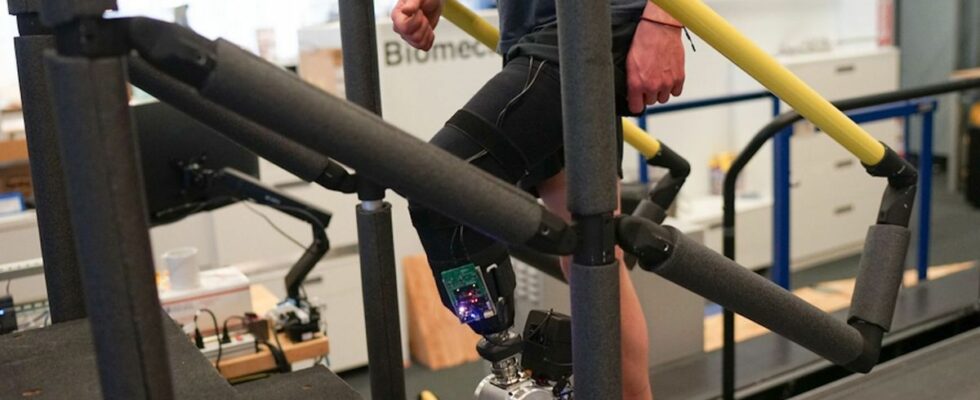Published on
Updated
Reading 2 min.
Giving amputees the ability to walk naturally as if they had a “real leg”. This is the feat achieved by an American team, which has succeeded in connecting a bionic prosthesis to the nerve signals of the remaining limb.
This innovative bionic leg uses a sophisticated computer interface that amplifies nerve signals from the muscles in the remaining part of the leg, allowing the user to control the prosthesis more naturally.
A new kind of prosthesis
Traditional bionic limbs rely on predefined algorithms to facilitate movement, which can limit the user’s control and the natural sensation of walking. To overcome this problem, Hugh Herr, a biophysicist at the Massachusetts Institute of Technology (MIT), and his team created an interface that directly uses nerve and muscle signals from the residual limb.
In the clinical trial, seven participants underwent surgery to connect their residual muscles, forming an “agonist-antagonist myoneural interface (AMI).” This technique mimics natural muscle movements, reducing pain, preserving muscle mass, and improving the fit and comfort of the bionic prosthesis.
The bionic leg consists of a prosthetic ankle equipped with sensors and electrodes that capture electrical signals on the surface of the skin. These signals emitted by the muscles at the amputation site are decoded by a small computer, which translates them into natural movement. Weighing 2.75 kilograms, the prosthesis is comparable to the weight of a “natural limb”.
41% faster natural walking
The 14 participants trained with their bionic legs for six hours, after which their performance was compared to that of the control group. The AMI significantly increased muscle signal rates to 10.5 pulses per second, far surpassing the control group’s 0.7 pulses per second (although this is still lower than the 60 pulses per second of natural muscles.
In the study, those using the new prosthesis walked 41 percent faster than those with standard prostheses. They also showed better balance, a better ability to change pace, climb stairs, walk on an incline, etc., according to the results published in Nature Medicine.
Levi Hargrove, a neural engineer at Northwestern University, said: “It is surprising that with a very short training, the participants were able to achieve such good results. They would have shown even greater benefits with a longer adaptation period.“.
A prosthesis that responds directly to brain orders
Herr, who lost both legs after being caught in a blizzard while climbing in 1982, expressed interest in adopting these interface devices for his own prosthetics in the future. He emphasized that despite the artificial components, the leg moves naturally without conscious effort.This is the first study to demonstrate a natural walking pattern with neural control in which the person’s brain is 100% in control of the bionic prosthesis, not a predefined robotic algorithm.“.
Making this progress accessible to all who need it
Future improvements could include reducing the weight of the leg and improving the durability of the electrodes to withstand daily use. Herr’s team is also exploring the possibility of replacing these electrodes with small implanted magnetic spheres to more accurately monitor muscle movements.This study lays the foundation we need to develop viable technologies and solutions for all amputees.” concludes Lenzi Hargrove.
